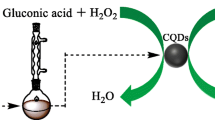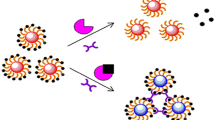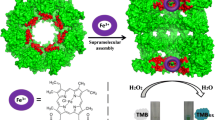Abstract
Here we developed a saccharic colorimetric method based on the combination of chemoselective ligation and enzyme-specific catalysis using aminooxy/hydrazine-functionalized gold nanoparticles (AO/AuNPs or H/AuNPs). In the detection of galactose (Gal), galactohexodialdose (GHDA), the galactose oxidase (GalOx)-catalyzed product, has an aldehyde group, which allows it to chemoselectively react with an aminooxy or hydrazine group at the outer layer of AO/AuNPs or H/AuNPs by oxime/hydrazone click chemistry to form oxime or hydrozone. Consequently, through the specific recognition of 1,4-phenylenediboronic acid (PDBA) on cis-diols, GHDA, which contains two pairs of hydroxyls in the cis form, can bind not only with AO/AuNPs or H/AuNPs, but also with PDBA to form boronate diester, thereby triggering the aggregation of AuNPs and causing the corresponding color change. As GalOx catalyzed specific substrates, the amount of Gal correlated with the production of GHDA and the extent of AuNPs aggregation, thus allowing a simple and easily operatable colorimetric method for Gal detection to be developed. Under the optimized experimental conditions, the ratios of absorbance at a wavelength of 617 nm to that at 536 nm vary linearly with the logarithmic values of Gal concentrations within a wide range of 500 nM to 5 mM. Moreover, this colorimetric method shows anti-interference capability and high sensitivity with a detection limit of 21 nM. Thus, a universal platform for accurate and specific colorimetric analysis can be established through the integration of chemoselective ligation with enzyme specific catalysis.

Similar content being viewed by others
References
Dirksen, A.; Dawson, P. E. Rapid oxime and hydrazone ligations with aromatic aldehydes for biomolecular labeling. Bioconjugate Chem. 2008, 19, 2543–2548.
Zhang, Y.; Yu, M.; Zhang, C.; Ma, W. F.; Zhang, Y. T.; Wang, C. C.; Lu, H. J. Highly selective and ultra fast solidphase extraction of N-glycoproteome by oxime click chemistry using aminooxy-functionalized magnetic nanoparticles. Anal. Chem. 2014, 86, 7920–7924.
Kitov, P. I.; Vinals, D. F.; Ng, S.; Tjhung, K. F.; Derda, R. Rapid, hydrolytically stable modification of aldehydeterminated proteins and phage libraries. J. Am. Chem. Soc. 2014, 136, 8149–8152.
Raindlová, V.; Pohl, R.; Šanda, M.; Hocek, M. Direct polymerase synthesis of reactive aldehyde-functionalized dna and its conjugation and staining with hydrazines. Angew. Chem., Int. Ed. 2010, 49, 1064–1066.
Chen, J.; Shah, P.; Zhang, H. Solid phase extraction of Nlinked glycopeptides using hydrazide tip. Anal. Chem. 2013, 85, 10670–10674.
Kajisa, T.; Sakata, T. Fundamental properties of phenylboronicacid- coated gate field-effect transistor for saccharide sensing. ChemElectroChem 2014, 1, 1647–1655.
Li, J.; Liu, L. L.; Wang, P. G.; Yang, Y.; Zheng, J. B. Amplified detection of saccharide based on redox-poly(phenolco- 3-hydroxyphenylboronic acid) coupling with a redox cycling. Sensor. Actuat. B-Chem. 2014, 198, 219–224.
Kejík, Z.; Bríza, T.; Králová, J.; Martásek, P.; Král, V. Selective recognition of a saccharide-type tumor marker with natural and synthetic ligands: A new trend in cancer diagnosis. Anal. Bioanal. Chem. 2010, 398, 1865–1870.
Sun, X. L.; Zhu, B.; Ji, D. K.; Chen, Q. B.; He, X. P.; Chen, G. R.; James, T. D. Selective fluorescence detection of monosaccharides using a material composite formed between graphene oxide and boronate-based receptors. ACS Appl. Mater. Interfaces 2014, 6, 10078–10082.
Kong, K. V.; Ho, C. J. H.; Gong, T. X.; Lau, W. K. O.; Olivo, M. Sensitive SERS glucose sensing in biological media using alkyne functionalized boronic acid on planar substrates. Biosens Bioelectron 2014, 56, 186–191.
Li, Y. P.; Jiang, L.; Zhang, T.; Lin, M.; Tian, D. B.; Huang, H. Colorimetric detection of glucose using a boronic acid derivative receptor attached to unmodified AuNPs. Chin. Chem. Lett. 2014, 25, 77–79.
Unnikrishnan, B.; Palanisamy, S.; Chen, S. M. A simple electrochemical approach to fabricate a glucose biosensor based on graphene-glucose oxidase biocomposite. Biosens. Bioelectron. 2013, 39, 70–75.
Kim, M. I.; Shim, J.; Li, T. H.; Woo, M. A.; Cho, D.; Lee, J.; Park, H. G. Colorimetric quantification of galactose using a nanostructured multi-catalyst system entrapping galactose oxidase and magnetic nanoparticles as peroxidase mimetics. Analyst 2012, 137, 1137–1143.
Gokoglan, T. C.; Soylemez, S.; Kesik, M.; Toksabay, S.; Toppare, L. Selenium containing conducting polymer based pyranose oxidase biosensor for glucose detection. Food Chem. 2015, 172, 219–224.
Lyons, C. T.; Stack, T. D. P. Recent advances in phenoxyl radical complexes of salen-type ligands as mixed-valent galactose oxidase models. Coordin. Chem. Rev. 2013, 257, 528–540.
Kanyong, P.; Pemberton, R. M.; Jackson, S. K.; Hart, J. P. Development of an amperometric screen-printed galactose biosensor for serum analysis. Anal. Biochem. 2013, 435, 114–119.
Hartmans, S.; de Vries, H. T.; Beijer, P.; Brady, R. L.; Hofbauer, M.; Haandrikman, A. J. Production of oxidized guar galactomannan and its applications in the paper industry. In Hemicelluloses: Science and Technology; Gatenholm, P.; Tenkanen, M., Eds.; American Chemical Society: Washington, DC,2004; pp 360–371.
Ioannou, A.; Cini, E.; Timofte, R. S.; Flitsch, S. L.; Turner, N. J.; Linclau, B. Heavily fluorinated carbohydrates as enzyme substrates: Oxidation of tetrafluorinated galactose by galactose oxidase. Chem. Commun. 2011, 47, 11228–11230.
Rannes, J. B.; Ioannou, A.; Willies, S. C.; Grogan, G.; Behrens, C.; Flitsch, S. L.; Turner, N. J. Glycoprotein labeling using engineered variants of galactose oxidase obtained by directed evolution. J. Am. Chem. Soc. 2011, 133, 8436–8439.
Turner, N. J. Enantioselective oxidation of C–O and C–N bonds using oxidases. Chem. Rev. 2011, 111, 4073–4087.
Leppänen, A. S.; Xu, C. L.; Parikka, K.; Eklund, P.; Sjö holm, R.; Brumer, H.; Tenkanen, M.; Willfö r, S. Targeted allylation and propargylation of galactose-containing polysaccharides in water. Carbohyd. Polym. 2014, 100, 46–54.
Parikka, K.; Leppänen, A. S.; Pitkänen, L.; Reunanen, M.; Willför, S.; Tenkanen, M. Oxidation of polysaccharides by galactose oxidase. J. Agric. Food Chem. 2010, 58, 262–271.
Charmantray, F.; Touisni, N.; Hecquet, L.; Mousty, C. Amperometric biosensor based on galactose oxidase immobilized in clay matrix. Electroanalysis 2013, 25, 630–635.
Tkác, J.; Gemeiner, P.; Šturdík, E. Rapid and sensitive galactose oxidase-peroxidase biosensor for galactose detection with prolonged stability. Biotechnol. Technique 1999, 13, 931–936.
Deng, J. J.; Yu, P.; Yang, L. F.; Mao, L. Q. Competitive coordination of Cu2+ between cysteine and pyrophosphate ion: Toward sensitive and selective sensing of pyrophosphate ion in synovial fluid of arthritis patients. Anal. Chem. 2013, 85, 2516–2522.
Zhang, M.; Liu, Y. Q.; Ye, B. C. Colorimetric assay for sulfate using positively-charged gold nanoparticles and its application for real-time monitoring of redox process. Analyst 2011, 136, 4558–4562.
Ge, S. G.; Liu, F.; Liu, W. Y.; Yan, M.; Song, X. R.; Yu, J. H. Colorimetric assay of K-562 cells based on folic acidconjugated porous bimetallic Pd@Au nanoparticles for pointof- care testing. Chem. Commun. 2014, 50, 475–477.
Gu, Y. J.; Cheng, J. P.; Lin, C. C.; Lam, Y. W.; Cheng, S. H.; Wong, W. T. Nuclear penetration of surface functionalized gold nanoparticles. Toxicol. Appl. Pharm. 2009, 237, 196–204.
Li, H. X.; Rothberg, L. Colorimetric detection of DNA sequences based on electrostatic interactions with unmodified gold nanoparticles. Proc. Natl. Acad. Sci. USA 2004, 101, 14036–14039.
Haiss, W.; Thanh, N. T. K.; Aveyard, J.; Fernig, D. G. Determination of size and concentration of gold nanoparticles from UV-Vis spectra. Anal. Chem. 2007, 79, 4215–4221.
Lou, T. T.; Chen, Z. P.; Wang, Y. Q.; Chen, L. X. Blue-tored colorimetric sensing strategy for Hg2+ and Ag+ via redox-regulated surface chemistry of gold nanoparticles. ACS Appl. Mater. Interfaces 2011, 3, 1568–1573.
Elghanian, R.; Storhoff, J. J.; Mucic, R. C.; Letsinger, R. L.; Mirkin, C. A. Selective colorimetric detection of polynucleotides based on the distance-dependent optical properties of gold nanoparticles. Science 1997, 277, 1078–1081.
Chen, G. H.; Chen, W. Y.; Yen, Y. C.; Wang, C. W.; Chang, H. T.; Chen, C. F. Detection of mercury(II) ions using colorimetric gold nanoparticles on paper-based analytical devices. Anal. Chem. 2014, 86, 6843–6849.
Zhu, K.; Zhang, Y.; He, S.; Chen, W. W.; Shen, J. Z.; Wang, Z.; Jiang, X. Y. Quantification of proteins by functionalized gold nanoparticles using click chemistry. Anal. Chem. 2012, 84, 4267–4270.
Liu, D. B.; Chen, W. W.; Wei, J. H.; Li, X. B.; Wang, Z.; Jiang, X. Y. A highly sensitive, dual-readout assay based on gold nanoparticles for organophosphorus and carbamate pesticides. Anal. Chem. 2012, 84, 4185–4191.
Kong, B.; Zhu, A. W.; Luo, Y. P.; Tian, Y.; Yu, Y. Y.; Shi, G. Y. Sensitive and selective colorimetric visualization of cerebral dopamine based on double molecular recognition. Angew. Chem., Int. Ed. 2011, 50, 1837–1840.
Brahim, S. I.; Maharajh, D.; Narinesingh, D.; Guiseppi-Elie, A. Design and characterization of a galactose biosensor using a novel polypyrrole-hydrogel composite membrane. Anal. Lett. 2002, 35, 797–812.
Şenel, M.; Bozgeyik, İ.; Çevik, E.; Fatih Abasiyanik, M. A novel amperometric galactose biosensor based on galactose oxidase-poly(N-glycidylpyrrole-co-pyrrole). Synthetic Met. 2011, 161, 440–444.
Author information
Authors and Affiliations
Corresponding authors
Electronic supplementary material
Rights and permissions
About this article
Cite this article
Zhang, J., Lv, J., Wang, X. et al. Integration of chemoselective ligation with enzymespecific catalysis: Saccharic colorimetric analysis using aminooxy/hydrazine-functionalized gold nanoparticles. Nano Res. 8, 3853–3863 (2015). https://doi.org/10.1007/s12274-015-0885-9
Received:
Revised:
Accepted:
Published:
Issue Date:
DOI: https://doi.org/10.1007/s12274-015-0885-9




